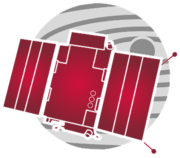| Mission type | Technology Space weather |
|---|---|
| Operator | European Space Agency[1] |
| COSPAR ID | 2009-059B |
| SATCAT no. | 36037 |
| Mission duration | 2 years (planned) 15 years and 20 days (in progress) |
| Spacecraft properties | |
| Bus | PROBA |
| Manufacturer | Verhaert Design & Development (now QinetiQ Space) |
| Launch mass | 120 kilograms (260 lb) |
| Dimensions | 0.60m x 0.70m x 0.85m |
| Power | 120 watts |
| Start of mission | |
| Launch date | 2 November 2009, 01:50:00 UTC |
| Rocket | Rokot/Briz-KM |
| Launch site | Plesetsk 133/3 |
| Orbital parameters | |
| Reference system | Geocentric |
| Regime | Sun-synchronous |
| Perigee altitude | 713 kilometres (443 mi)[2] |
| Apogee altitude | 733 kilometres (455 mi)[2] |
| Inclination | 98.28 degrees[2] |
| Period | 99.12 minutes[2] |
| Epoch | 24 January 2015, 13:01:08 UTC[2] |
 ESA solar system insignia for the PROBA-2 mission | |
PROBA-2 is the second satellite in the European Space Agency's series of PROBA low-cost satellites that are being used to validate new spacecraft technologies while also carrying scientific instruments.[3] PROBA-2 is a small satellite (130 kg) developed under an ESA General Support Technology Program (GSTP) contract by a Belgian consortium led by Verhaert (now QinetiQ Space) of Kruibeke, Belgium. The nominal mission duration was two years.[1] As of 2022, the mission continues.[4]
- ^ a b "PROBA-2 (Project for On-Board Autonomy-2)". ESA. Retrieved 2013-04-15.
- ^ a b c d e "PROBA-2 Satellite details 2009-059B NORAD 36037". N2YO. 24 January 2015. Retrieved 25 January 2015.
- ^ "About PROBA-2". ESA. 2012-12-02. Retrieved 2013-04-15.
- ^ "ESA Science & Technology - PROBA2".